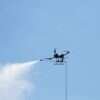There are regions of our planet’s vast surface that have not been affected by modern civilization, where time seems to have stopped, and where the natural world governs supreme. One such mysterious and remote location on Earth is North Sentinel Island, which is found in the Bay of Bengal. Is it possible to fly a drone to North Sentinel Island, an island located in mystery and seclusion?
Drones have added new dimensions to our exploration as well as awareness of the environment by allowing us to fly over landscapes and take stunning aerial photographs. However, by pushing the limits of the possibilities, drones also raise questions on the ethical, statutory, and practical limitations.
This is particularly evident in the case of North Sentinel Island. The Sentinelese tribe, one of the last uncontacted peoples on earth, calls North Sentinel Island home. This becomes even more evident in the case of this island.
We embarked on a journey in the following article to investigate the difficulties associated with the use of drone North Sentinel Island.
We will explore the unique geographic and cultural aspects of the island, the moral conundrums that arise, the legal system that protects the Sentinelese people, and the practical difficulties that make drone flights over this island risky.
About North Sentinel Island:
North Sentinel Island is a part of the Andaman and Nicobar Islands region, regulated by India. This small, densely forested island is 59.67 square kilometers in size, and it is encircled by coral reefs. The isolated location of this island from the outer world adds to its attraction.
For generations, the Sentinelese people, who are estimated to number between 50 and 150, have fiercely disliked interaction with the outside world. They are regarded as the most isolated people on Earth and are notorious for their mistrust towards outsiders.
By forbidding any unauthorized communication or trips to the island, the Indian government has implemented a policy to safeguard their isolation.
The Ethical Conundrum:
It’s crucial to think about the moral consequences before exploring the viability of flying a drone north sentinel island. It is important to respect the Sentinelese people’s decision to stay isolated. Without their permission, any attempt to fly a body drone north Sentinel Island would be against both their rights and morality.
Additionally, because the Sentinelese are vulnerable to diseases against which they lack immunity, contact with outsiders could be fatal for them. Drones and other alien items could unintentionally introduce these diseases to the island, which could have disastrous effects on the local population.
The Legal System:
Legally, it is not allowed to fly a north sentinel island drone. To safeguard the Sentinelese people and their way of life, the Indian government has put in place strict conditions for entry.
The North Sentinel Island Reserve is off-limits to visitors, and the Sentinelese tribe cannot be contacted there either, according to the Andaman and Nicobar (Protection of Aboriginal Tribes) Regulation, 1956.
Moreover, the rights of indigenous peoples to preserve their cultural and geographical integrity are highlighted in international conventions and treaties, such as the United Nations Declaration on the Rights of Indigenous Peoples. The importance of respecting the Sentinelese people’s isolation is further emphasized by these legal systems.
Real-Life Issues in Flying a Drone Over North Sentinel Island:
Dense Vegetation:
The canopy of the thick and dense tropical vegetation covers North Sentinel Island. This creates a big challenge for a drone operator. It is quite difficult to fly a north sentinel island drone safely through such dense forests.
The drone’s flight route can easily be blocked by tall trees and dense vegetation, which could cause crashes and equipment loss. It is a troubling chance for drone flights because of the significant chance of becoming entangled in branches or canopy cover.
Hostile Environment:
The hostility of the Sentinelese people is one of the most significant difficulties when considering drone flights over North Sentinel Island. They are renowned for aggressively guarding their isolation and frequently retaliating violently when others approach too closely.
The drone and the people involved in the operation could both be at risk if an attempt is made to fly a drone to North Sentinel Island. The risk increases as the Sentinelese may view a drone as an aggressive invasion because of their lack of exposure to the modern world.
Bay of Bengal Weather Conditions:
North Sentinel Island is situated in the Bay of Bengal, which is renowned for its unpredictable and often dangerous weather patterns. In this area, tropical storms and cyclones frequently occur. Even for seasoned operators, these unfavorable weather conditions make it extremely difficult to undertake safe drone flights. Any attempt to operate a drone could be dangerous or ineffective due to strong winds, heavy rain, and turbulence in the atmosphere.
Limited Visibility:
Flying a drone over an isolated island that is densely vegetated, like North Sentinel, requires sensitive control and precise navigation. However, the drone operator’s ability to maintain visual contact with the aircraft may be impaired by the poor visibility brought on by the dense foliage.
This reduced visibility puts the drone’s operation at serious risk because it makes it more challenging to avoid obstructions and maintain a safe flying route. Drone flights are now considerably risky due to the additional difficulty of suspected Sentinelese opposition. Limited visibility is already a difficult problem.
The Final Answer!
In conclusion, it is not only morally and legally wrong but also technically difficult to fly a body drone North Sentinel Island. Respecting the Sentinelese people’s isolation is important, and any attempt to break into their land would be risky and irresponsible.
Unquestionably, drones have drastically changed the way we explore and document the world, but there are some situations when the advantages of technology must yield to moral and legal issues. One such location is North Sentinel Island, where the protection of the Sentinelese way of life and their isolation must come before the interest of drone enthusiasts or researchers.
We should put more effort into respecting the cultural and environmental diversity of our world and striving towards sustainable coexistence with the last unexplored regions of the Earth rather than concentrating on flying drones over sensitive and restricted areas.
Related Posts:







